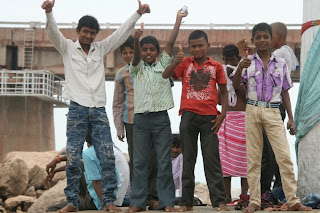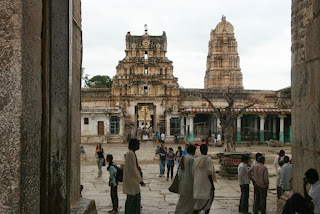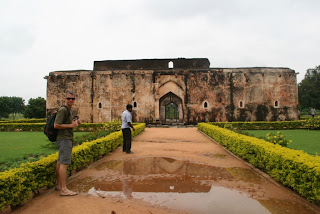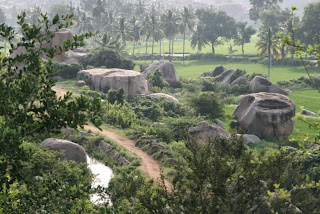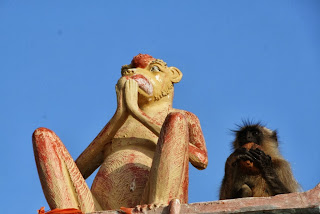Sept. 8th, 2013
Naomi and I thought we’d have a relatively relaxed Sunday but
we decided to cross the river and walk through Virupaksha Temple which
dominates the centre of Hampi. After
some breakfast in the Mango Tree we wandered to the temple just 50 some metres
away. It began to rain so we hung out for
a bit in the covering of the entrance and who would walk up but Kumar, our tour
guide from the other day. We asked if
he’d give us a short walking tour of the temple and adjoining Hema Hill and the
various structures on it. He agreed but
told us that the main temple was closing in 15 minutes for a couple of hours
for the lunch period. We decided to go
for it, paid our 10 rupee entrance fee plus 50 for taking photos and scrambled
in. Before entering the inner area, you
have to take off your shoes. With the
myriad of animals walking around inside: cows, monkeys, Laxmi the elephant...you
have to pay heed as to where you step and not think about it too much.
Three men and a dog watching life go by:
The entrance to Virupaksha:
Some others hiding from the rain in the entrance:
We did a quick round of the temple and I definitely learned
more this time from Kumar than my last visit with no guide. We began up the neighbouring hill, Hema Hill,
which is a massive pieces of rock that is nicely rounded. Here and there are some small temple
buildings. Kumar, with the help of a
little strategic questioning from us, gave us more of a lesson on Hinduism than
all of the specifics of the buildings and carvings. I found the stories interesting but so
fanciful and I help but feel a confirmation of my growing feeling of how strange
and farcical the backgrounds of today’s religions are. Sorry if I’m offending anyone, but we’re all
entitled to our opinion.
A cow enjoying the temple:
And monkeys doing the same:
Naomi receiving a blessing from Laxmi:
Worth the 50 rupees!
A structure (ancient phone booth?) on Hema Hill:
Yay us! Feeling a bit like the Flintstones.
Hello Ganesh
The busy boat ride back at the end of the day:
The next morning we met up with Kumar for our rickshaw tour
of some outlying temples (after our mandatory Mango Tree breakfast). We began with the furthest away temple and
technically the star of today’s show, the Vittala Temple with its stone chariot
which is a UNESCO World Heritage Site.
The rickshaw was parked about a kilometre away and we hopped on a super
long golf cart to be shuttled to the temple.
Along the straight gravel road were fallen down and leaning columns
along with some nice horses owned by some nomads that were in the area.
Sadly I can't remember the name of this guy but he's like the third incarnation of Shiva or something...and he was my favourite statue:
Just as I had experienced at the Taj Mahal, another UNESCO
site, foreigners have to fork out 500 rupees ($8-9) while Indians only pay 10
rupees to get in. I’m totally okay with
this and in fact think it’s a good idea.
It allows most Indians the ability to see the major attractions in their
county and this is additionally important as very few Indians will be fortunate
to have the opportunity to experience international travel.
There weren’t many people in the temple which was a large
open courtyard with a stone wall perimeter and a number of small rock buildings
with one in the centre and the others spaced around it. The chariot was near the entrance but before
we snapped pics with it, Kumar showed us probably the coolest aspect of the
temple. The stone columns holding up the
roof of one structure have these smaller columns on the side of them and if you
put your ear to one, the others could be played musically by tapping your
finger on it. Naomi and I listened in as
Kumar hammered out some rhythm.
Kumar and me at the famed chariot:
An ancient tree near the centre temple:
Everyone looks better with sunglasses, flowers behind their ear and horses in the background:
Check out the centipede!
Next was the Queen’s Bath, back towards Hampi which was a
massive structure some royal lady from some 500 years ago used to clean up and
she could even work on her breaststroke as the bath was so big. We visited another large ruin/temple site and
then on to the Lotus Temple with its accompanying Royal Elephant Stables. I think Naomi and I were getting “templed”
out at this point and it worked out well that this lawyer couple from London,
Jesse and Hannah, to whom we’d recommended Kumar to as a guide, showed up and
basically we tagged out and they carried on.
The Queen's Bath:
It's a bit empty though:
Up on what seemed like a shaved off pyramid, with storm clouds looming:
We were slight celebrities:
Naomi capturing the Lotus Temple:
The Elephant Stables:
Don't ask...
Cool, another big bug!
Although tired, we decided to hike up Hemakuta Hill which we
had skirted by the other day going to Achyutaraya Temple and is about a
kilometre away from the big temple of Virupaksha. It has a wonderful 360 degree view of the
area and was worth the 10 minute hike up.
There were dark clouds and obvious rain falling in the distance but
thankfully we were fine.
Looking down to Achyutaraya Temple:
Towards the water reservoir and the river:
Gorgeous!
Naomi contemplating life:
The main temple in town is just left of center:

We hooked up with Jesse and Hannah that evening to take a
rickshaw to the previously visited Anegundi village. Tonight was Ganesha Chaturthi, the big
celebration of one of the most revered Hindu gods. Kumar had told us the story of Ganesha and I’ll
try to tell it accurately but there may be some mistakes, and who knows if what
Kumar said is what supposedly happened as there are many theories. Two of the main Hindu gods, Shiva and his
wife Parvati, are involved. Shiva left
Parvati for a long time to go and pray somewhere distant. Parvati was unknowingly pregnant and gave
birth to a boy, Ganesha. The boy grew
up. Parvati seemed to like taking long
showers and she was concerned that someone might come in and see her so she had
Ganesha stand out at the front gate and keep guard. Shiva returned unannounced
and when he was refused entrance to see his beloved wife by this young boy, he
chopped off his head, not knowing that it was his son. Parvati told him and Shiva raced off to find
another head for Ganesha from the first animal he would find, and what did he
find? An Elephant. An hence this god with an elephant head that
is one of the most popular with the Hindus as he promises prosperity for
believers.
Ganesh Chaturthi is the annual celebration of Ganesh and
typically households or groups make or buy a statue of Ganesh which they keep
in their home for days culminating in the release him into a large body of
water, be it the ocean, a river or a lake.
Various castes celebrate for a different number of days and also have
their peak night at differing times.
This means lots of fireworks, lady finger firecrackers and happy people
over the course of a week or more but tonight was supposed to be the peak for
Anegundi.
Immediately after arriving, we walked into a welcoming house
with quite a display of various coloured lights, all types of flowers, a big
Ganesha statue and many happy Indians. A
roped off walkway led us in and we were offered tikkas (a smear of coloured
powder on your forehead between your eyes), to throw some grains of rice at
Ganesh and then a palm full of this sweet, white powdered stuff that I can’t
say I could finish so I serendipitously dumped it behind me.
The entrance to our first house:
Our first Ganesha:
Trying out the sweet stuff:
Ganesh and all his buddies, the Justice League of Hinduism:
We continued from celebrating house to celebrating house
littered around town including one with some young teenage boys busting a move
to some energetic music. We couldn’t
help but jump in...this is what visiting foreign places is about, soaking up
the experience. What a great evening.
Everybody's got their take on Ganesh:
Naomi posing with a happy bunch:
Gettin' down with the locals:
Happy Ganesh Chaturthi!








